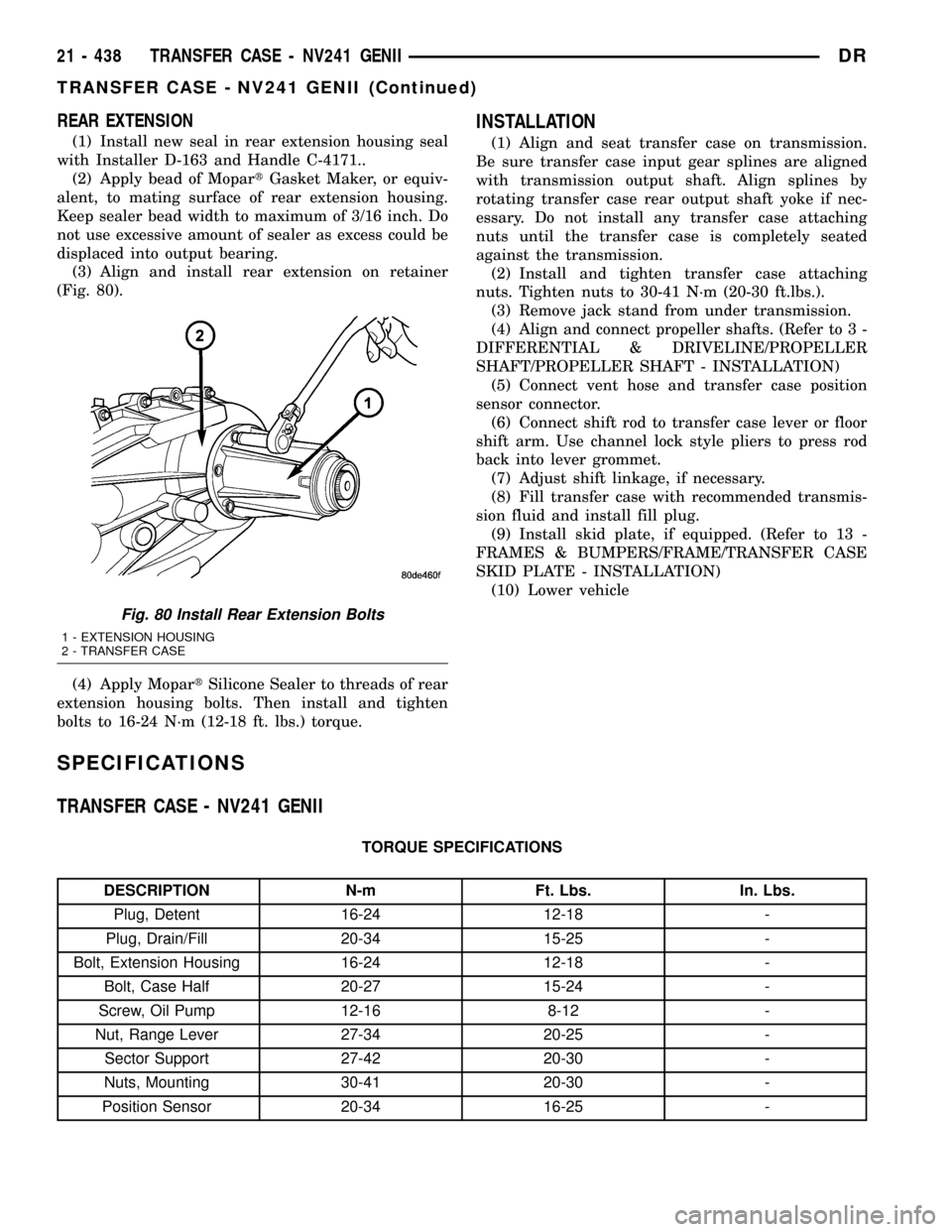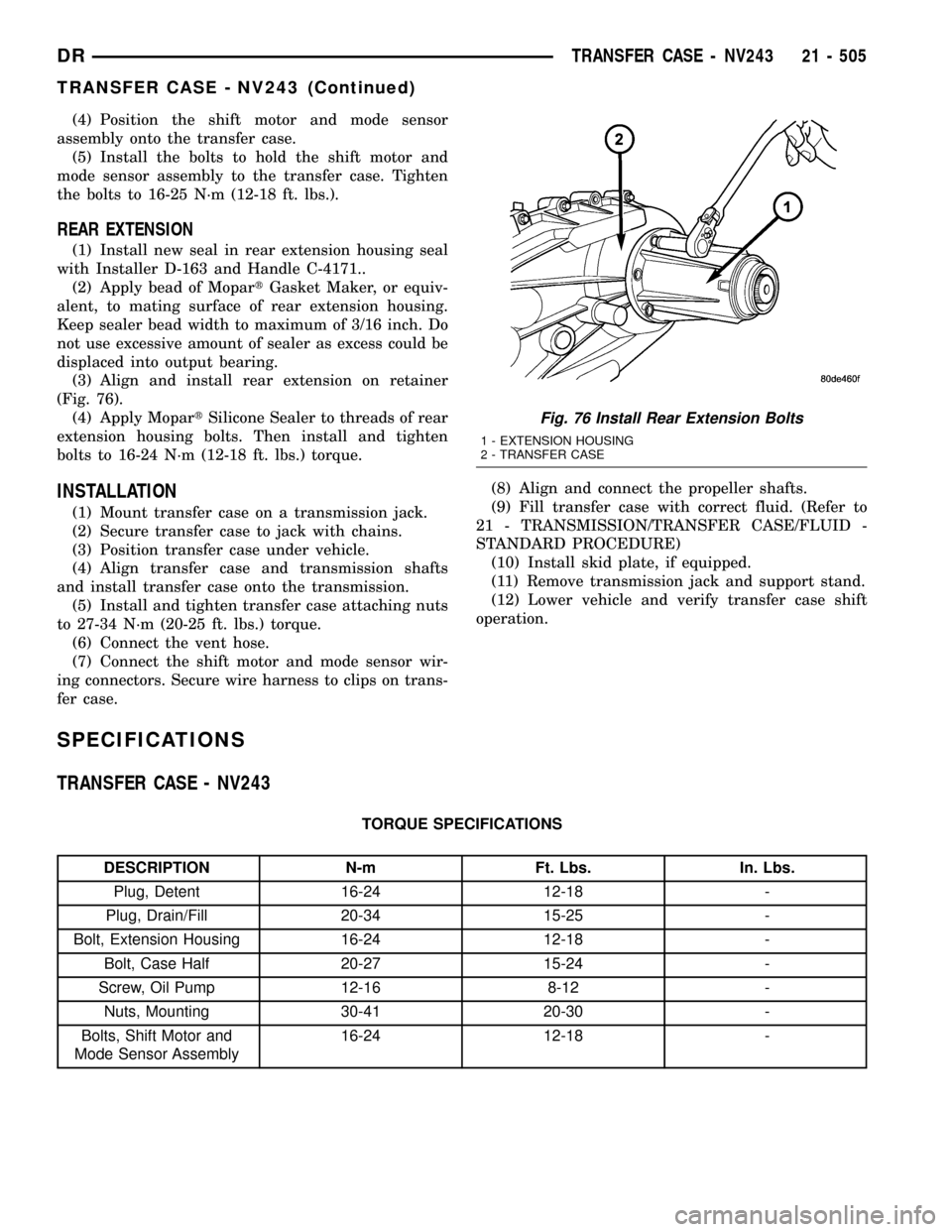transmission oil DODGE RAM 1500 1998 2.G Workshop Manual
[x] Cancel search | Manufacturer: DODGE, Model Year: 1998, Model line: RAM 1500, Model: DODGE RAM 1500 1998 2.GPages: 2627
Page 2120 of 2627

Condition Possible Cause Correction
Noisy in, or jumps out of, four wheel
drive low range.1) Transfer case not completely
engaged in 4L position.1) With the transmission in
NEUTRAL, or the clutch depressed
in the case of a manual
transmission and the vehicle moving
under 3-4 km/h (2-3 mph), shift the
transfer case to NEUTRAL and then
shift into the 4L position.
2) Shift linkage out of adjustment. 2) Adjust linkage.
3) Shift linkage loose or binding. 3) Tighten, lubricate, or repair
linkage as necessary.
4) Range fork damaged, inserts
worn, or fork is binding on the shift
rail.4) Disassemble unit and repair as
necessary.
5) Low range gear worn or
damaged.5) Disassemble unit and repair as
necessary.
Lubricant leaking from output shaft
seal or vent.1) Transfer case overfilled. 1) Drain lubricant to the correct
level.
2) Vent closed or restricted. 2) Clear or replace vent as
necessary.
3) Output shaft seals damaged or
installed incorrectly.3) Replace seal as necessary.
Check to ensure that another
component, the propeller shaft slip
yoke for example, is not causing
damage to seal.
Abnormal tire wear. 1) Extended operation on hard, dry
surfaces in the 4H position.1) Operate vehicle in the 2H
position on hard, dry surfaces.
REMOVAL
(1) Raise and support vehicle.
(2) Remove skid plate, if equipped. (Refer to 13 -
FRAMES & BUMPERS/FRAME/TRANSFER CASE
SKID PLATE - REMOVAL)
(3) Position drain oil container under transfer
case.
(4) Remove transfer case drain plug and drain
lubricant into container.
(5) Disconnect vent hose and transfer case position
sensor connector.
(6) Disconnect shift rod from grommet in transfer
case shift lever, or from floor shift arm whichever
provides easy access. Use channel lock style pliers to
press rod out of lever grommet.
(7) Support transmission with jack stand.
(8) Mark front and rear propeller shafts for assem-
bly reference.(9) Remove front and rear propeller shafts. (Refer
to 3 - DIFFERENTIAL & DRIVELINE/PROPELLER
SHAFT/PROPELLER SHAFT - REMOVAL)
(10) Support transfer case with suitable jack.
Secure transfer case to jack with safety chains.
(11) Remove nuts attaching transfer case to trans-
mission.
(12) Move transfer case assembly rearward until
free of transmission output shaft.
(13) Lower jack and move transfer case from
under vehicle.
DISASSEMBLY
Position transfer case in a shallow drain pan.
Remove drain plug and drain any remaining lubri-
cant remaining in case.
DRTRANSFER CASE - NV241 GENII 21 - 417
TRANSFER CASE - NV241 GENII (Continued)
Page 2141 of 2627

REAR EXTENSION
(1) Install new seal in rear extension housing seal
with Installer D-163 and Handle C-4171..
(2) Apply bead of MopartGasket Maker, or equiv-
alent, to mating surface of rear extension housing.
Keep sealer bead width to maximum of 3/16 inch. Do
not use excessive amount of sealer as excess could be
displaced into output bearing.
(3) Align and install rear extension on retainer
(Fig. 80).
(4) Apply MopartSilicone Sealer to threads of rear
extension housing bolts. Then install and tighten
bolts to 16-24 N´m (12-18 ft. lbs.) torque.
INSTALLATION
(1) Align and seat transfer case on transmission.
Be sure transfer case input gear splines are aligned
with transmission output shaft. Align splines by
rotating transfer case rear output shaft yoke if nec-
essary. Do not install any transfer case attaching
nuts until the transfer case is completely seated
against the transmission.
(2) Install and tighten transfer case attaching
nuts. Tighten nuts to 30-41 N´m (20-30 ft.lbs.).
(3) Remove jack stand from under transmission.
(4) Align and connect propeller shafts. (Refer to 3 -
DIFFERENTIAL & DRIVELINE/PROPELLER
SHAFT/PROPELLER SHAFT - INSTALLATION)
(5) Connect vent hose and transfer case position
sensor connector.
(6) Connect shift rod to transfer case lever or floor
shift arm. Use channel lock style pliers to press rod
back into lever grommet.
(7) Adjust shift linkage, if necessary.
(8) Fill transfer case with recommended transmis-
sion fluid and install fill plug.
(9) Install skid plate, if equipped. (Refer to 13 -
FRAMES & BUMPERS/FRAME/TRANSFER CASE
SKID PLATE - INSTALLATION)
(10) Lower vehicle
SPECIFICATIONS
TRANSFER CASE - NV241 GENII
TORQUE SPECIFICATIONS
DESCRIPTION N-m Ft. Lbs. In. Lbs.
Plug, Detent 16-24 12-18 -
Plug, Drain/Fill 20-34 15-25 -
Bolt, Extension Housing 16-24 12-18 -
Bolt, Case Half 20-27 15-24 -
Screw, Oil Pump 12-16 8-12 -
Nut, Range Lever 27-34 20-25 -
Sector Support 27-42 20-30 -
Nuts, Mounting 30-41 20-30 -
Position Sensor 20-34 16-25 -
Fig. 80 Install Rear Extension Bolts
1 - EXTENSION HOUSING
2 - TRANSFER CASE
21 - 438 TRANSFER CASE - NV241 GENIIDR
TRANSFER CASE - NV241 GENII (Continued)
Page 2153 of 2627

REMOVAL
(1) Raise and support vehicle.
(2) Remove skid plate, if equipped. (Refer to 13 -
FRAMES & BUMPERS/FRAME/TRANSFER CASE
SKID PLATE - REMOVAL)
(3) Position drain oil container under transfer
case.
(4) Remove transfer case drain plug and drain
lubricant into container.
(5) Disconnect vent hose and transfer case position
sensor connector.
(6) Disconnect shift rod from grommet in transfer
case shift lever, or from floor shift arm whichever
provides easy access. Use channel lock style pliers to
press rod out of lever grommet.
(7) Support transmission with jack stand.
(8) Mark front and rear propeller shafts for assem-
bly reference.
(9) Remove front and rear propeller shafts. (Refer
to 3 - DIFFERENTIAL & DRIVELINE/PROPELLER
SHAFT/PROPELLER SHAFT - REMOVAL)
(10) Support transfer case with suitable jack.
Secure transfer case to jack with safety chains.
(11) Remove nuts attaching transfer case to trans-
mission.
(12) Move transfer case assembly rearward until
free of transmission output shaft.
(13) Lower jack and move transfer case from
under vehicle.
DISASSEMBLY
Position transfer case in a shallow drain pan.
Remove drain plug and drain any remaining lubri-
cant remaining in case.
COMPANION FLANGE AND EXTENSION HOUSING
(1) Install two bolts 180É apart into the front out-
put shaft companion flange.
(2) Place holder over the bolts and against the
companion flange (Fig. 3).
(3) Remove and discard the front companion flange
nut.
(4) Remove the companion flange from the front
output shaft. It may be necessary to use Flange
puller 8992 to remove the companion flange.
(5) Use a suitable chisel or pry tool to remove the
rear extension housing dust boot (Fig. 4).
(6) Use a suitable chisel or pry tool to remove the
rear extension housing seal.
Fig. 3 Remove Companion Flange Nut
1 - HOLDER 6719
2 - BOLTS
Fig. 4 Remove Extension Housing Dust Boot
1 - EXTENSION HOUSING
2 - DUST BOOT
21 - 450 TRANSFER CASE - NV271DR
TRANSFER CASE - NV271 (Continued)
Page 2169 of 2627

(7) Install snap-ring to hold input/low range gear
into front bearing (Fig. 62).
(8) Install a new input gear seal using Installer
8841 and Handle C-4171.
(9) Install a new input gear oil seal with Installer
9036 and Handle C-4171.
SHIFT FORKS AND MAINSHAFT
(1) Lubricate mainshaft splines with recommended
transmission fluid.
(2) Coat the interior of the drive sprocket hub with
ATF+4 and install the drive sprocket drive hub (Fig.
63) onto the mainshaft.(3) Install the mode hub (Fig. 64) onto the main-
shaft.
(4) Install the mode hub retaining ring (Fig. 65)
onto the mainshaft.
Fig. 62 Install Input Gear Retaining Ring
1 - INPUT GEAR
2 - RETAINING RING
Fig. 63 Install the Drive Sprocket Drive Hub
1 - MAINSHAFT
2 - DRIVE SPROCKET DRIVE HUB
Fig. 64 Install Mode Hub
1 - MAINSHAFT
2 - MODE HUB
Fig. 65 Install Mode Hub Retaining Ring
1 - MAINSHAFT
2 - MODE HUB
3 - RETAINING RING
21 - 466 TRANSFER CASE - NV271DR
TRANSFER CASE - NV271 (Continued)
Page 2208 of 2627

(4) Position the shift motor and mode sensor
assembly onto the transfer case.
(5) Install the bolts to hold the shift motor and
mode sensor assembly to the transfer case. Tighten
the bolts to 16-25 N´m (12-18 ft. lbs.).
REAR EXTENSION
(1) Install new seal in rear extension housing seal
with Installer D-163 and Handle C-4171..
(2) Apply bead of MopartGasket Maker, or equiv-
alent, to mating surface of rear extension housing.
Keep sealer bead width to maximum of 3/16 inch. Do
not use excessive amount of sealer as excess could be
displaced into output bearing.
(3) Align and install rear extension on retainer
(Fig. 76).
(4) Apply MopartSilicone Sealer to threads of rear
extension housing bolts. Then install and tighten
bolts to 16-24 N´m (12-18 ft. lbs.) torque.
INSTALLATION
(1) Mount transfer case on a transmission jack.
(2) Secure transfer case to jack with chains.
(3) Position transfer case under vehicle.
(4) Align transfer case and transmission shafts
and install transfer case onto the transmission.
(5) Install and tighten transfer case attaching nuts
to 27-34 N´m (20-25 ft. lbs.) torque.
(6) Connect the vent hose.
(7) Connect the shift motor and mode sensor wir-
ing connectors. Secure wire harness to clips on trans-
fer case.(8) Align and connect the propeller shafts.
(9) Fill transfer case with correct fluid. (Refer to
21 - TRANSMISSION/TRANSFER CASE/FLUID -
STANDARD PROCEDURE)
(10) Install skid plate, if equipped.
(11) Remove transmission jack and support stand.
(12) Lower vehicle and verify transfer case shift
operation.
SPECIFICATIONS
TRANSFER CASE - NV243
TORQUE SPECIFICATIONS
DESCRIPTION N-m Ft. Lbs. In. Lbs.
Plug, Detent 16-24 12-18 -
Plug, Drain/Fill 20-34 15-25 -
Bolt, Extension Housing 16-24 12-18 -
Bolt, Case Half 20-27 15-24 -
Screw, Oil Pump 12-16 8-12 -
Nuts, Mounting 30-41 20-30 -
Bolts, Shift Motor and
Mode Sensor Assembly16-24 12-18 -
Fig. 76 Install Rear Extension Bolts
1 - EXTENSION HOUSING
2 - TRANSFER CASE
DRTRANSFER CASE - NV243 21 - 505
TRANSFER CASE - NV243 (Continued)
Page 2264 of 2627

(7) Install snap-ring to hold input/low range gear
into front bearing (Fig. 61).
(8) Install a new input gear seal using Installer
8841 and Handle C-4171.
(9) Install a new input gear oil seal with Installer
9036 and Handle C-4171.
SHIFT FORKS AND MAINSHAFT
(1) Lubricate mainshaft splines with recommended
transmission fluid.
(2) Coat the interior of the drive sprocket hub with
ATF+4 and install the drive sprocket drive hub (Fig.
62) onto the mainshaft.(3) Install the mode hub (Fig. 63) onto the main-
shaft.
(4) Install the mode hub retaining ring (Fig. 64)
onto the mainshaft.
Fig. 61 Install Input Gear Retaining Ring
1 - INPUT GEAR
2 - RETAINING RING
Fig. 62 Install the Drive Sprocket Drive Hub
1 - MAINSHAFT
2 - DRIVE SPROCKET DRIVE HUB
Fig. 63 Install Mode Hub
1 - MAINSHAFT
2 - MODE HUB
Fig. 64 Install Mode Hub Retaining Ring
1 - MAINSHAFT
2 - MODE HUB
3 - RETAINING RING
DRTRANSFER CASE - NV273 21 - 561
TRANSFER CASE - NV273 (Continued)
Page 2531 of 2627

DIAGNOSIS AND TESTING - REFRIGERANT
SYSTEM LEAKS
WARNING: R-134a SERVICE EQUIPMENT OR VEHI-
CLE A/C SYSTEM SHOULD NOT BE PRESSURE
TESTED OR LEAK TESTED WITH COMPRESSED
AIR. MIXTURE OF AIR and R-134a CAN BE COM-
BUSTIBLE AT ELEVATED PRESSURES. THESE MIX-
TURES ARE POTENTIALLY DANGEROUS AND MAY
RESULT IN FIRE OR EXPLOSION CAUSING INJURY
OR PROPERTY DAMAGE.
AVOID BREATHING A/C REFRIGERANT AND LUBRI-
CANT VAPOR OR MIST. EXPOSURE MAY IRRITATE
EYES, NOSE AND THROAT. USE ONLY APPROVED
SERVICE EQUIPMENT MEETING SAE REQUIRE-
MENTS TO DISCHARGE R-134a SYSTEM. IF ACCI-
DENTAL SYSTEM DISCHARGE OCCURS,
VENTILATE WORK AREA BEFORE RESUMING SER-
VICE.
NOTE: The refrigerant system does come from the
factory with a yellow tracer dye already installed to
aid in detection of leaks.
If the A/C system is not cooling properly, determine
if the refrigerant system is fully charged with
R-134a. This is accomplished by performing a system
Charge Level-Check or Fill. If while performing this
test A/C liquid line pressure is less than 345 kPa (50
psi) proceed to System Empty procedure. If liquid
line pressure is greater than 345 kPa (50 psi) proceed
to System Low procedure. If the refrigerant system is
empty or low in refrigerant charge, a leak at any line
fitting or component seal is likely. A review of the fit-
tings, lines and components for oily residue is an
indication of the leak location. To detect a leak in the
refrigerant system, perform one of the following pro-
cedures as indicated by the symptoms.
SYSTEM EMPTY
(1) Evacuate the refrigerant system to the lowest
degree of vacuum possible (approx. 28 in Hg.). Deter-
mine if the system holds a vacuum for 15 minutes. If
vacuum is held, a leak is probably not present. If sys-
tem will not maintain vacuum level, proceed with
this procedure.(2) Prepare a 0.284 Kg. (10 oz.) refrigerant charge
to be injected into the system.
(3) Connect and dispense 0.284 Kg. (10 oz.) of
refrigerant into the evacuated refrigerant system.
(4) Proceed to Step 2 of System Low procedure.
SYSTEM LOW
(1) Determine if there is any (R-134a) refrigerant
in the system.
(2) Position the vehicle in a wind free work area.
This will aid in detecting small leaks.
(3) Bring the refrigerant system up to operating
temperature and pressure. This is done by allowing
the engine to run for five minutes with the system
set to the following:
²Transmission in Park or Neutral with parking
brake set
²Engine idling at 700 rpm
²A/C controls set in 100 percent outside air
²Blower switch in the high A/C position
²A/C in the ON position
²Open all windows
CAUTION: A leak detector designed for R-12 refrig-
erant (only) will not detect leaks in a R-134a refrig-
erant system.
(4) Shut off the vehicle and wait 2 to 7 minutes.
Then use an Electronic Leak Detector that is
designed to detect R-134a type refrigerant and search
for leaks. Fittings, lines, or components that appear
to be oily usually indicates a refrigerant leak. To
inspect the evaporator core for leaks, insert the leak
detector probe into the drain tube opening or a heat
duct. A R-134a dye is available to aid in leak detec-
tion, use only DaimlerChrysler approved refrigerant
dye.
24 - 44 PLUMBINGDR
PLUMBING (Continued)
Page 2535 of 2627

After the system has been tested for leaks and
evacuated, a refrigerant (R-134a) charge can be
injected into the system.
NOTE: When connecting the service equipment
coupling to the line fitting, verify that the valve of
the coupling is fully closed. This will reduce the
amount of effort required to make the connection.
(1) If using a separate vacuum pump close all
valves before disconnecting pump. Connect manifold
gauge set to the A/C service ports.
NOTE: Always refer to the underhood HVAC Speci-
fication label for the refrigerant fill level of the vehi-
cle being serviced.
(2) Measure refrigerant (refer to capacities). Refer
to the instructions provided with the equipment
being used.
(3) Verify engine is shut off. Open the suction and
discharge valves. Open the charge valve to allow the
refrigerant to flow into the system. When the trans-
fer of refrigerant has stopped, close the suction and
discharge valve.
(4) If all of the charge did not transfer from the
dispensing device, put vehicle controls into the fol-
lowing mode:
²Automatic transmission in park or manual
transmission in neutral
²Engine at idle
²A/C mode control set to outside air
²A/C mode control set to panel mode
²A/C temperature control set to full cool
²Blower motor control set on highest speed
²Vehicle windows closed
If the A/C compressor does not engage, test the
compressor clutch control circuit and correct any fail-
ure (Refer to 8 - ELECTRICAL/WIRING DIAGRAM
INFORMATION - DIAGNOSIS AND TESTING).
(5) Open the suction valve to allow the remaining
refrigerant to transfer to the system.
WARNING: TAKE CARE NOT TO OPEN THE DIS-
CHARGE (HIGH-PRESSURE) VALVE AT THIS TIME.
(6) Close all valves and test the A/C system perfor-
mance.
(7) Disconnect the charging station or manifold
gauge set. Install the service port caps.
REFRIGERANT CHARGE CAPACITY
The R-134a refrigerant system charge capacity for
this vehicle can be found on the underhood HVAC
specfication tag.
A/C COMPRESSOR
DESCRIPTION
DESCRIPTION - A/C COMPRESSOR
The A/C system on models equipped with the 5.9L
engine use a Sanden SD-7 reciprocating swash plate-
type compressor. This compressor has a fixed dis-
placement of 165 cubic centimeter (10.068 cubic
inches) and has both the suction and discharge ports
located on the cylinder head.
The A/C system on models equipped with the 3.7L,
4.7L and 5.7L engines use a Denso 10S17 reciprocat-
ing swash plate-type compressor. This compressor
has a fixed displacement of 170 cubic centimeter and
has both the suction and discharge ports located on
the cylinder head.
A label identifying the use of R-134a refrigerant is
located on both A/C compressors.
DESCRIPTION - HIGH PRESSURE RELIEF
VALVE
A high pressure relief valve is located on the com-
pressor cylinder head, which is on the rear of the
compressor. This mechanical valve is designed to
vent refrigerant from the system to protect against
damage to the compressor and other system compo-
nents, caused by condenser air flow restriction or an
overcharge of refrigerant.
OPERATION
OPERATION - A/C COMPRESSOR
The A/C compressor is driven by the engine
through an electric clutch, drive pulley and belt
arrangement. The compressor is lubricated by refrig-
erant oil that is circulated throughout the refrigerant
system with the refrigerant.
The compressor draws in low-pressure refrigerant
vapor from the evaporator through its suction port. It
then compresses the refrigerant into a high-pressure,
high-temperature refrigerant vapor, which is then
pumped to the condenser through the compressor dis-
charge port.
The compressor cannot be repaired. If faulty or
damaged, the entire compressor assembly must be
replaced. The compressor clutch, pulley and clutch
coil are available for service.
OPERATION - HIGH PRESSURE RELIEF VALVE
The high pressure relief valve vents the system
when a discharge pressure of 3445 to 4135 kPa (500
to 600 psi) or above is reached. The valve closes
24 - 48 PLUMBINGDR
PLUMBING (Continued)
Page 2536 of 2627

when a minimum discharge pressure of 2756 kPa
(400 psi) is reached.
The high pressure relief valve vents only enough
refrigerant to reduce the system pressure, and then
re-seats itself. The majority of the refrigerant is con-
served in the system. If the valve vents refrigerant, it
does not mean that the valve is faulty.
The high pressure relief valve is a factory-cali-
brated unit. The valve cannot be adjusted or
repaired, and must not be removed or otherwise dis-
turbed. The valve is only serviced as a part of the
compressor assembly.
DIAGNOSIS AND TESTING - A/C COMPRESSOR
When investigating an air conditioning related
noise, you must first know the conditions under
which the noise occurs. These conditions include:
weather, vehicle speed, transmission in gear or neu-
tral, engine speed, engine temperature, and any
other special conditions. Noises that develop during
air conditioning operation can often be misleading.
For example: What sounds like a failed front bearing
or connecting rod, may be caused by loose bolts, nuts,
mounting brackets, or a loose compressor clutch
assembly.
Drive belts are speed sensitive. At different engine
speeds and depending upon belt tension, belts can
develop noises that are mistaken for a compressor
noise. Improper belt tension can cause a misleading
noise when the compressor clutch is engaged, which
may not occur when the compressor clutch is disen-
gaged. Check the serpentine drive belt condition and
tension as described in Cooling before beginning this
procedure.
(1) Select a quiet area for testing. Duplicate the
complaint conditions as much as possible. Switch the
compressor on and off several times to clearly iden-
tify the compressor noise. Listen to the compressor
while the clutch is engaged and disengaged. Probe
the compressor with an engine stethoscope or a long
screwdriver with the handle held to your ear to bet-
ter localize the source of the noise.
(2) Loosen all of the compressor mounting hard-
ware and retighten. Tighten the compressor clutch
mounting nut. Be certain that the clutch coil is
mounted securely to the compressor, and that the
clutch plate and rotor are properly aligned and have
the correct air gap (Refer to 24 - HEATING & AIR
CONDITIONING/CONTROLS/A/C COMPRESSOR
CLUTCH - INSTALLATION).
(3) To duplicate a high-ambient temperature condi-
tion (high head pressure), restrict the air flow
through the condenser. Install a manifold gauge set
or a DRBIIItscan tool to be certain that the dis-
charge pressure does not exceed 2760 kPa (400 psi).(4) Check the refrigerant system plumbing for
incorrect routing, rubbing or interference, which can
cause unusual noises. Also check the refrigerant lines
for kinks or sharp bends that will restrict refrigerant
flow, which can cause noises (Refer to 24 - HEATING
& AIR CONDITIONING/PLUMBING - STANDARD
PROCEDURE).
(5) If the noise is from opening and closing of the
high pressure relief valve, recover, evacuate and
recharge the refrigerant system (Refer to 24 - HEAT-
ING & AIR CONDITIONING/PLUMBING - STAN-
DARD PROCEDURE), (Refer to 24 - HEATING &
AIR CONDITIONING/PLUMBING - STANDARD
PROCEDURE - REFRIGERANT SYSTEM EVACU-
ATE) and (Refer to 24 - HEATING & AIR CONDI-
TIONING/PLUMBING - STANDARD PROCEDURE -
REFRIGERANT SYSTEM CHARGE). If the high
pressure relief valve still does not seat properly,
replace the compressor (Refer to 24 - HEATING &
AIR CONDITIONING/PLUMBING/A/C COMPRES-
SOR - REMOVAL).
(6) If the noise is from liquid slugging on the suc-
tion line, replace the accumulator (Refer to 24 -
HEATING & AIR CONDITIONING/PLUMBING/AC-
CUMULATOR - REMOVAL) and check the refriger-
ant oil level and the refrigerant system charge (Refer
to 24 - HEATING & AIR CONDITIONING/PLUMB-
ING/REFRIGERANT OIL - STANDARD PROCE-
DURE) (Refer to 24 - HEATING & AIR
CONDITIONING/PLUMBING/ACCUMULATOR -
REMOVAL). If after replacing the accumulator the
slugging condition still exists then replace the com-
pressor.(Refer to 24 - HEATING & AIR CONDITION-
ING/PLUMBING/A/C COMPRESSOR - REMOVAL).
(7) If the liquid slugging condition continues fol-
lowing accumulator replacement, replace the com-
pressor and repeat Step 1.
REMOVAL
WARNING: REVIEW THE WARNINGS AND CAU-
TIONS IN THE FRONT OF THIS SECTION BEFORE
PERFORMING THE FOLLOWING OPERATION (Refer
to 24 - HEATING & AIR CONDITIONING/PLUMBING -
WARNING) and (Refer to 24 - HEATING & AIR CON-
DITIONING/PLUMBING - CAUTION).
NOTE: The A/C compressor may be removed and
repositioned without disconnecting the refrigerant
lines or discharging the refrigerant system. Dis-
charging is not necessary if servicing the compres-
sor clutch, clutch coil, engine, engine cylinder head
or the generator.
(1) Recover the refrigerant from the refrigerant
system (Refer to 24 - HEATING & AIR CONDITION-
DRPLUMBING 24 - 49
A/C COMPRESSOR (Continued)
Page 2588 of 2627

INDEX
ABS - DESCRIPTION, BRAKES...........5-45
ABS - OPERATION, BRAKES.............5-45
ABS BRAKE BLEEDING - STANDARD
PROCEDURE.........................5-46
ABS INDICATOR - DESCRIPTION.........8J-17
ABS INDICATOR - OPERATION..........8J-17
A/C COMPRESSOR - DESCRIPTION......24-48
A/C COMPRESSOR - DIAGNOSIS AND
TESTING...........................24-49
A/C COMPRESSOR - OPERATION........24-48
A/C COMPRESSOR CLUTCH BREAK-IN -
STANDARD PROCEDURE...............24-10
A/C COMPRESSOR CLUTCH COIL -
DIAGNOSIS AND TESTING.............24-10
A/C COMPRESSOR CLUTCH RELAY -
DESCRIPTION.......................24-13
A/C COMPRESSOR CLUTCH RELAY -
INSTALLATION.......................24-14
A/C COMPRESSOR CLUTCH RELAY -
OPERATION.........................24-13
A/C COMPRESSOR CLUTCH RELAY -
REMOVAL..........................24-14
A/C COMPRESSOR CLUTCH/COIL -
DESCRIPTION........................24-9
A/C COMPRESSOR CLUTCH/COIL -
INSPECTION........................24-11
A/C COMPRESSOR CLUTCH/COIL -
INSTALLATION.......................24-12
A/C COMPRESSOR CLUTCH/COIL -
OPERATION..........................24-9
A/C COMPRESSOR CLUTCH/COIL -
REMOVAL..........................24-10
A/C CONDENSER - DESCRIPTION........24-52
A/C CONDENSER - OPERATION..........24-52
A/C DISCHARGE LINE - DESCRIPTION....24-56
A/C EVAPORATOR - DESCRIPTION.......24-59
A/C EVAPORATOR - INSTALLATION......24-60
A/C EVAPORATOR - OPERATION.........24-59
A/C EVAPORATOR - REMOVAL..........24-60
A/C HEATER CONTROL - DESCRIPTION . . . 24-14
A/C HEATER CONTROL - INSTALLATION . . . 24-15
A/C HEATER CONTROL - REMOVAL......24-15
A/C ORIFICE TUBE - DESCRIPTION.......24-60
A/C ORIFICE TUBE - DIAGNOSIS AND
TESTING...........................24-61
A/C ORIFICE TUBE - OPERATION........24-60
A/C PERFORMANCE - DIAGNOSIS AND
TESTING............................24-3
A/C PRESSURE TRANSDUCER -
DESCRIPTION.......................24-15
A/C PRESSURE TRANSDUCER -
DIAGNOSIS AND TESTING.............24-16
A/C PRESSURE TRANSDUCER -
INSTALLATION.......................24-16
A/C PRESSURE TRANSDUCER -
OPERATION.........................24-16
A/C PRESSURE TRANSDUCER -
REMOVAL..........................24-16
A/C SYSTEM - SPECIFICATIONS..........24-7
A/C SYSTEM, CAUTION................24-43
A/C SYSTEM, WARNING...............24-43
ACCELERATOR PEDAL - INSTALLATION . . . 14-21
ACCELERATOR PEDAL - REMOVAL.......14-21
ACCELERATOR PEDAL POSITION
SENSOR - DESCRIPTION.........14-22,14-68
ACCELERATOR PEDAL POSITION
SENSOR - INSTALLATION.........14-22,14-71
ACCELERATOR PEDAL POSITION
SENSOR - OPERATION...........14-22,14-68
ACCELERATOR PEDAL POSITION
SENSOR - REMOVAL.............14-22,14-68
ACCESSORY DRIVE BELT - DIAGNOSIS
AND TESTING....................7-24,7-27
ACCUMULATOR - DESCRIPTION.........24-61
ACCUMULATOR - DESCRIPTION........21-193
ACCUMULATOR - INSPECTION.........21-194
ACCUMULATOR - INSTALLATION........24-62
ACCUMULATOR - OPERATION..........24-61
ACCUMULATOR - OPERATION..........21-193
ACCUMULATOR - REMOVAL............24-61
ACM COVER - INSTALLATION
...........8O-10
ACM COVER - REMOVAL
..............8O-10
ACTUATION TEST MODE - DESCRIPTION,
CIRCUIT
.............................25-1
ACTUATOR - DESCRIPTION, BLEND
DOOR
.............................24-17
ACTUATOR - DESCRIPTION, DEFROST
DOOR
.............................24-20ACTUATOR - DESCRIPTION, FUEL
CONTROL..........................14-74
ACTUATOR - DESCRIPTION, MODE
DOOR.............................24-23
ACTUATOR - DESCRIPTION,
RECIRCULATION DOOR................24-24
ACTUATOR - INSTALLATION, BLEND
DOOR.............................24-18
ACTUATOR - INSTALLATION, DEFROST
DOOR.............................24-21
ACTUATOR - INSTALLATION, INSIDE
HANDLE.......................23-22,23-32
ACTUATOR - INSTALLATION, MODE
DOOR.............................24-23
ACTUATOR - INSTALLATION,
RECIRCULATION DOOR................24-25
ACTUATOR - OPERATION, BLEND DOOR . . 24-17
ACTUATOR - OPERATION, DEFROST
DOOR.............................24-21
ACTUATOR - OPERATION, FUEL
CONTROL..........................14-74
ACTUATOR - OPERATION, MODE DOOR . . . 24-23
ACTUATOR - OPERATION,
RECIRCULATION DOOR................24-24
ACTUATOR - REMOVAL, BLEND DOOR....24-17
ACTUATOR - REMOVAL, DEFROST DOOR . . 24-21
ACTUATOR - REMOVAL, FUEL CONTROL . . 14-74
ACTUATOR - REMOVAL, INSIDE HANDLE . 23-22,
23-31
ACTUATOR - REMOVAL, MODE DOOR....24-23
ACTUATOR - REMOVAL, RECIRCULATION
DOOR...............................24-24
ADAPTER HOUSING SEAL -
INSTALLATION...........21-128,21-364,21-85
ADAPTER HOUSING SEAL - REMOVAL . . 21-128,
21-364,21-85
ADAPTER MOUNT - INSTALLATION, DISC
BRAKE CALIPER......................5-22
ADHESIVE LOCATIONS -
SPECIFICATIONS, STRUCTURAL........23-112
ADJUSTABLE PEDAL MOTOR -
DESCRIPTION.........................5-6
ADJUSTABLE PEDAL MOTOR -
INSTALLATION.........................5-7
ADJUSTABLE PEDAL MOTOR - REMOVAL . . . 5-7
ADJUSTABLE PEDAL SWITCH -
INSTALLATION.........................5-6
ADJUSTABLE PEDAL SWITCH -
REMOVAL............................5-6
ADJUSTER - DIAGNOSIS AND TESTING,
HYDRAULIC LASH................9-125,9-32
ADJUSTER - INSTALLATION, SEAT BELT
TURNING LOOP.....................8O-55
ADJUSTER - REMOVAL, SEAT BELT
TURNING LOOP.....................8O-55
ADJUSTER ASSEMBLY - DESCRIPTION,
ROCKER ARM.......................9-125
ADJUSTER ASSEMBLY - INSTALLATION,
ROCKER ARM.......................9-126
ADJUSTER ASSEMBLY - REMOVAL,
ROCKER ARM.......................9-126
ADJUSTER ASSY - CLEANING, ROCKER
ARM ..............................9-262
ADJUSTER ASSY - DESCRIPTION,
ROCKER ARM.......................9-261
ADJUSTER ASSY - INSPECTION,
ROCKER ARM.......................9-262
ADJUSTER ASSY - INSTALLATION,
ROCKER ARM..................9-203,9-263
ADJUSTER ASSY - REMOVAL, ROCKER
ARM .........................9-203,9-261
ADJUSTING TOOL - ADJUSTMENT, WITH . . . 5-42
AFTER A SUPPLEMENTAL RESTRAINT
DEPLOYMENT - STANDARD
PROCEDURE, SERVICE.................8O-7
AIR CHECKING TRANSMISSION CLUTCH
OPERATION - DIAGNOSIS AND
TESTING..........................21-317
AIR CLEANER ELEMENT - INSTALLATION
. 9-107,
9-21,9-249
AIR CLEANER ELEMENT - REMOVAL
. 9-107,9-21,
9-248
AIR CONDITIONER - DESCRIPTION,
HEATER
.............................24-1
AIR CONDITIONER - OPERATION,
HEATER
.............................24-1
AIR CONTROL MOTOR - DESCRIPTION,
IDLE
...............................14-28AIR CONTROL MOTOR - INSTALLATION,
IDLE...............................14-29
AIR CONTROL MOTOR - OPERATION,
IDLE...............................14-28
AIR CONTROL MOTOR - REMOVAL, IDLE . . 14-29
AIR COOLER AND PLUMBING -
CLEANING, CHARGE..................11-17
AIR COOLER AND PLUMBING -
DESCRIPTION, CHARGE...............11-16
AIR COOLER AND PLUMBING -
INSPECTION, CHARGE.................11-17
AIR COOLER AND PLUMBING -
INSTALLATION, CHARGE...............11-17
AIR COOLER AND PLUMBING -
OPERATION, CHARGE.................11-16
AIR COOLER AND PLUMBING -
REMOVAL, CHARGE..................11-17
AIR COOLER SYSTEM - LEAKS -
DIAGNOSIS AND TESTING, CHARGE......11-16
AIR DAM - INSTALLATION, FRONT........13-2
AIR DAM - REMOVAL, FRONT...........13-2
AIR HEATER - DESCRIPTION, INTAKE.....14-80
AIR HEATER - INSTALLATION, INTAKE....14-80
AIR HEATER - OPERATION, INTAKE......14-80
AIR HEATER - REMOVAL, INTAKE........14-80
AIR HEATER RELAY - DESCRIPTION,
INTAKE ............................14-82
AIR HEATER RELAY - INSTALLATION,
INTAKE ............................14-82
AIR HEATER RELAY - OPERATION,
INTAKE ............................14-82
AIR HEATER RELAY - REMOVAL, INTAKE . . 14-82
AIR INTAKE SYSTEM - INSTALLATION....9-199
AIR INTAKE SYSTEM - REMOVAL........9-199
AIR OUTLETS - DESCRIPTION..........24-26
AIR OUTLETS - INSTALLATION..........24-27
AIR OUTLETS - REMOVAL.............24-26
AIR TEMPERATURE SENSOR -
DESCRIPTION, INTAKE................14-30
AIR TEMPERATURE SENSOR -
INSTALLATION, INTAKE................14-31
AIR TEMPERATURE SENSOR -
OPERATION, INTAKE..................14-30
AIR TEMPERATURE SENSOR -
REMOVAL, INTAKE...................14-30
AIR TEMPERATURE SENSOR/MAP
SENSOR - DESCRIPTION, INTAKE........14-82
AIR TEMPERATURE SENSOR/MAP
SENSOR - INSTALLATION, INTAKE.......14-82
AIR TEMPERATURE SENSOR/MAP
SENSOR - OPERATION, INTAKE.........14-82
AIR TEMPERATURE SENSOR/MAP
SENSOR - REMOVAL, INTAKE...........14-82
AIR TEMPERATURE SENSOR/PRESSURE
SENSOR - DESCRIPTION, INLET.........14-79
AIR TEMPERATURE SENSOR/PRESSURE
SENSOR - INSTALLATION, INLET........14-79
AIR TEMPERATURE SENSOR/PRESSURE
SENSOR - OPERATION, INLET..........14-79
AIR TEMPERATURE SENSOR/PRESSURE
SENSOR - REMOVAL, INLET............14-79
AIR TESTING TRANSMISSION CLUTCH
AND BAND OPERATION - DIAGNOSIS
AND TESTING......................21-144
AIR TO OIL COOLER - INSTALLATION.....7-70
AIR TO OIL COOLER - REMOVAL.........7-69
AIRBAG - ASSEMBLY, DRIVER..........8O-26
AIRBAG - DESCRIPTION, DRIVER........8O-23
AIRBAG - DESCRIPTION, PASSENGER....8O-39
AIRBAG - DESCRIPTION, SIDE CURTAIN . . 8O-56
AIRBAG - DISASSEMBLY, DRIVER.......8O-25
AIRBAG - INSTALLATION, DRIVER.......8O-28
AIRBAG - INSTALLATION, PASSENGER . . . 8O-41
AIRBAG - INSTALLATION, SIDE CURTAIN . . 8O-58
AIRBAG - OPERATION, DRIVER.........8O-23
AIRBAG - OPERATION, PASSENGER......8O-40
AIRBAG - OPERATION, SIDE CURTAIN....8O-56
AIRBAG - REMOVAL, DRIVER...........8O-24
AIRBAG - REMOVAL, PASSENGER.......8O-40
AIRBAG - REMOVAL, SIDE CURTAIN.....8O-57
AIRBAG CONTROL MODULE -
DESCRIPTION
.......................8O-11
AIRBAG CONTROL MODULE -
INSTALLATION
......................8O-13
AIRBAG CONTROL MODULE -
OPERATION
.........................8O-11
AIRBAG CONTROL MODULE - REMOVAL
. . 8O-12
AIRBAG INDICATOR - DESCRIPTION
......8J-18
DRINDEX 1
Description Group-Page Description Group-Page Description Group-Page